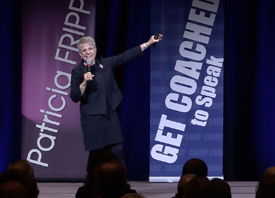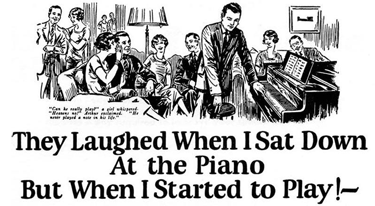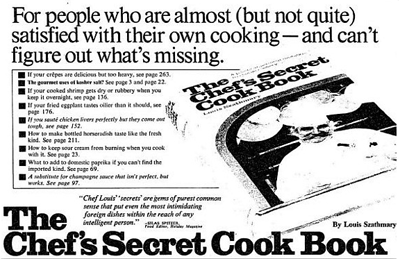
Developing a powerful and persuasive presentation begins with thoughtful structure and careful word choices. Speakers can benefit from learning the secrets of good writers. I share this fascinating article from Ragan Communications explaining the psychological strategies copywriters use to craft headlines. Courtney Seiter explains how and why effective copy works on even the most distracted audience:
8 Successful Headlines and The Psychology Behind Them
by Courtney SeiterHave you ever wondered why how-to or numbered-list headlines get so many clicks? Here’s your answer. I recently dug into research about headlines to prepare for a webinar on the science of writing must-click headlines on social media. I found plenty of data about which words are in the most-shared headlines, how long headlines should be, and more.
What was especially interesting were the psychology behind some well-known headline formulas and what makes them so clickable. Here’s an overview of eight winning headline formulas and the psychology behind them:
1. Surprise
Chip and Dan Heath, authors of “Made to Stick: Why Some Ideas Survive and Others Die,” list surprise as one of the six principles of sticky ideas. According to their research, presenting something unexpected—breaking a pattern—will help you capture attention.
This works in two parts: Surprise captures our interest and holds it.
Our brains love novelty. The brain’s pleasure centers are more “turned on” when we experience unpredictable pleasant events, compared with expected pleasant events.
Surprises are more stimulating and will get our attention much more easily than things we already know well—even if we really like those things. We may subconsciously prefer an unpredictable experience over what we think we want.
One example of surprise would be the email subject lines of Barack Obama’s presidential campaign. Anyone who shared an address with the campaign got messages from Barack Obama with subject lines like “Hey,” “Wow,” or “Join me for dinner?”
Dropping in curse words like “Hell yeah, I like Obamacare” also got big clicks. Most of the $690 million that Obama raised online came from these fundraising emails. These emails worked because they created a surprising dissonance between Barack Obama and email subject lines that looked as if they had come from a friend.
2. Questions
Questions are powerful because they pique curiosity. Simply seeing a question mark stimulates your brain. If you already know what you’re going to get from a headline, your curiosity might be over before it can even start.
The best question headlines ask something the reader can empathize with, relate to, or would like answered. Consider this one by Bill Jayme in Psychology Today, “Do You Close The Bathroom Door Even When You’re The Only One Home?”
Note how your brain springs into action as you think about your answer and wonder how it compares against other people’s answers.
3. Curiosity
Upworthy has gained millions of clicks by taking advantage of a psychological phenomenon called the curiosity gap.
George Loewenstein, a professor at Carnegie Mellon University, coined this term to describe the gap between what we know and want to know. When we notice a gap in our knowledge, we feel deprived. We look for that piece of missing information to ease that feeling.
Curiosity requires some initial knowledge. We’re not curious about something we know nothing about, but as soon as we know even a little bit our curiosity is piqued and we want to learn more. Research shows that curiosity increases with knowledge—the more we know, the more we want to know.
A Cal Tech study scanned volunteers’ brains while they read trivia questions designed to create a mixture of high and low curiosity. When subjects were interested in a question, the researchers saw more activity in the caudate region—a part of the brain that anticipates rewards. (Interesting side note: If subjects found out they gave an incorrect answer, the curiosity effect seemed even stronger.)
To use this strategy in headlines, share some intriguing but incomplete information. Tell the reader enough to pique his curiosity, but not enough to give the whole story away. This famous ad by John Caples does this well:
Created in 1926, the ad went on to become one of the most popular and successful ads in history. Scott Delong, the founder of viral content site ViralNova, has it framed in his office.
The ad doesn’t sell piano lessons; it intrigues with the emotional benefit of learning a new skill.
4. Negatives
Superlatives—words such as “best,” “biggest,” and “greatest”—can be effective in headlines, but negative superlatives (like “worst”) can be even more powerful.
In a study of 65,000 headlines, Outbrain compared positive, negative, and no superlative headlines. The study found that headlines with positive superlatives performed 29 percent worse and headlines with negative superlatives performed 30 percent better. The average click-through rate on headlines with negative superlatives was 63 percent higher than positive ones.
There are a few theories on why this might be:
- Positive superlatives have become clichéd through overuse.
- Negatives are more intriguing because they’re unexpected and surprising.
- Negatives tap into our insecurities. Using negative words like “stop,” “avoid” and “don’t” work because everyone wants to find out if there’s something they’re doing that they should stop.
Somewhat related is a finding from a Startup Moon study of 100 tech blogs that found that aggressive or violent-sounding words like “kill,” “dead,” and “fear” actually encouraged more social shares.
(Note: Because Buffer values positivity and happiness, we tend to turn this technique inside out. Headlines like “10 Things to Stop Doing Today to be Happier, Backed by Science” have done really well.)
5. How to
A lot of advertising writers say that if you start with the words “how to,” you can’t write a bad headline. After all, we all want to be smarter.
Copyblogger say these types of headlines go beyond knowledge to work on an even deeper level:
“Most people don’t want information. I know you’ve always been taught otherwise, but it’s true. People are drowning in facts. What people really want is a sense of order and predictability in their lives. We want to feel a sense of power over our world. Therefore, we seek out the secrets, tips, hints, laws, rules, and systems that promise to help us gain control and make sense of things.”
Witness the incredible staying power of one of the most famous how-to headlines: “How to Win Friends and Influence People” by Dale Carnegie.
Even with this proven formula, there are a few tweaks we can make to ensure our headlines spread.
A Startup Moon tech blogs headline study found a huge difference between the viral spread of a post titled “How to use Android SDK” and another titled “The beginners guide to Android SDK.” It’s the same concept, but different packaging. Adding words like “Introduction,” “The beginners guide,” “In 5 minutes” and “DIY” can provide more viral variations on the how-to headline.
This tells us you might want to work something specific into your headline to give readers a better idea of what they’re going to get. For example, instead of “How to get better at organizing your day,” you might try, “The 5-minute guide to organizing your day for more focus and productivity.”
6. Numbers
Numbers work well in headlines because people like predictability.
A study on the psychology of waiting in line found that when we don’t know how long something will take, we experience that time differently.
If a patient in a waiting room is told the doctor is running 30 minutes late, the patient might be annoyed but will eventually relax into the wait. However, if the patient is told the doctor will be ready soon, the patient is nervous and unable to settle down because he thinks he’ll see the doctor soon. When we’re in this situation, time feels as though it moves more slowly.
Numbers manage expectations for us—they tell us exactly what we’re getting into. That might be why a Conductor study found that audiences prefer number headlines to almost any other type.
Additionally, the Startup Moon headline study found that the bigger the number, the farther the post spreads.
7. Audience referencing
Audience referencing basically means using the word “you,” or directly implicating your audience with your headline. Copywriter Mel Martin was known for this. He would write headlines like “For golfers who are almost (but not quite) satisfied with their game—and can’t figure out what they’re doing wrong,” and this similar variation:
This headline type gets attention because of the way our brains fixate on solving problems. It’s part of our survival instinct for our brains to actively search for potential problems—even if they’re as minor as a golf swing or cooking. When you are the precise target audience for a headline, your brain says, “That’s for me!”
In a Norwegian study, researchers tried a variety of headline styles on a shopping website:
- “For sale: Black iPhone4 16GB” (the regular headline)
- “Anyone need a new iPhone4?” (question headline without referencing cues)
- “Is this your new iPhone4?” (question headline with referencing cues)
Researchers found that question headlines with audience-referencing cues (“Is this your new iPhone4?”) produced higher click-throughs than other headline types.
Even if you don’t use the audience-referencing strategy, keep in mind how strong human self-interest is. When you speak to the desires, needs and emotions of your reader, you answer their main question: “What’s in it for me?”
8. Specificity
Another principle that makes ideas stick, according to Chip and Dan Heath, is to use specific facts rather than broad statements.
Specific, quantifiable facts—particularly those that evoke mental pictures—are intensely interesting. Figures imply research, which adds to your legitimacy, but all kinds of specificity are good: digits, names, descriptions, titles, examples, projections, results. Being specific also demonstrates that the article will be in depth.
Being specific appeals to our urge to know what we’ll get when we click, and leads to greater clarity. Readers prefer clarity, according to a recent Conductor study.
It’s also worth noting that the folks at Upworthy, who were previously high on curiosity-gap headlines, are now finding that descriptive headlines—headlines that tell you exactly what the content is—are starting to win out over curiosity-gap headlines that tease you by withholding details.
Curiosity-gap headlines used to work because people weren’t used to them, but they’re now common.
As you try these strategies, you may find that one headline type works really well for a while, and then begins to show diminishing returns. The key is to keep finding new ways to engage your audience. Be playful and experimental with what you write—and ruthless with how you test.
Courtney Seiter creates content at Buffer. Follow her @courtneyseiter. Buffer helps you and your team manage multiple social media accounts at once. A version of this article originally appeared on the Buffer blog, and on the Ragan Communications website.
Thank you Courtney and Ragan Communications! I have had the honor of keynoting the Ragan Speechwriters Conference several times and have also attended as a participant. Ragan Communications is the go-to resource for information about communications and writing.
 Imagine a training program that gives you 24/7 access to one of the most in-demand executive speech coaches and sales presentation experts. Fripp Virtual Training is designed to be immediately engaging and makes it fun to learn. If you are a novice presenter or a seasoned professional, you will find the content both practical and relevant.
Imagine a training program that gives you 24/7 access to one of the most in-demand executive speech coaches and sales presentation experts. Fripp Virtual Training is designed to be immediately engaging and makes it fun to learn. If you are a novice presenter or a seasoned professional, you will find the content both practical and relevant.
Sign up for your complimentary seven-day trial and discover how Fripp VT can transform you and your team. Fripp VT delivers high-caliber comprehensive presentation and sales presentations skills training with built in accountability. http://frippvt.com
“As the author of a best-selling sales book, I receive invitations to speak at meetings and conferences. A trusted colleague told me the best investment he made in his speaking career was to hire speech coach Patricia Fripp. After three days locked in a room with her, I realize he is right. Patricia is a master at helping structure and script your presentation.”
Andy Paul, Author, Zero Time Selling
Executive Speech Coach and Hall of Fame Keynote Speaker Patricia Fripp is hired by individuals and companies who realize that powerful, persuasive presentation skills give them a competitive edge.


